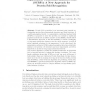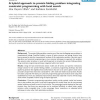258 search results - page 13 / 52 » Predicting protein folding pathways |
RECOMB
2005
Springer
14 years 9 months ago
2005
Springer
Abstract. Protein fold recognition is an important step towards understanding protein three-dimensional structures and their functions. A conditional graphical model, i.e. segmenta...
BMCBI
2010
13 years 9 months ago
2010
Background: The protein folding problem remains one of the most challenging open problems in computational biology. Simplified models in terms of lattice structure and energy func...
ICASSP
2007
IEEE
14 years 3 months ago
2007
IEEE
Protein structure prediction aims to determine the three-dimensional structure of proteins form their amino acid sequences. When a protein does not have similarity (homology) to a...
NAR
2007
13 years 8 months ago
2007
With the integration of the KEGG and Predictome databases as well as two search engines for coexpressed genes/proteins using data sets obtained from the Stanford Microarray Databa...
BMCBI
2005
13 years 9 months ago
2005
Background: Accurate assignment of genes to pathways is essential in order to understand the functional role of genes and to map the existing pathways in a given genome. Existing ...


